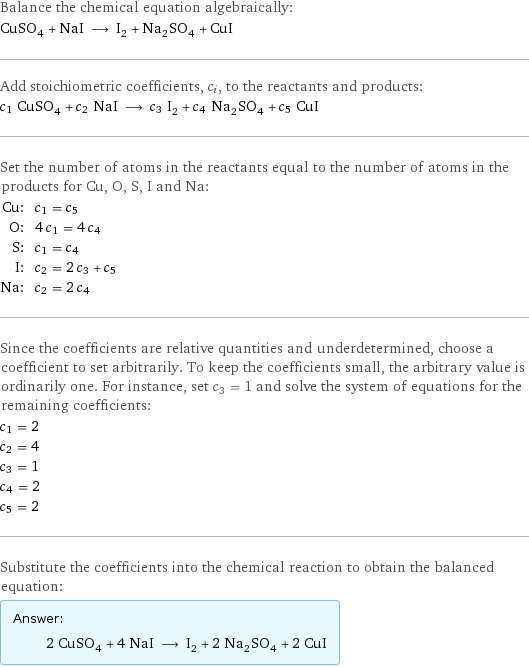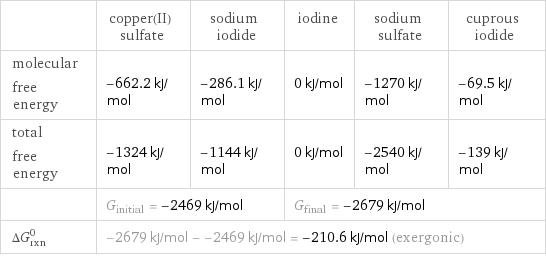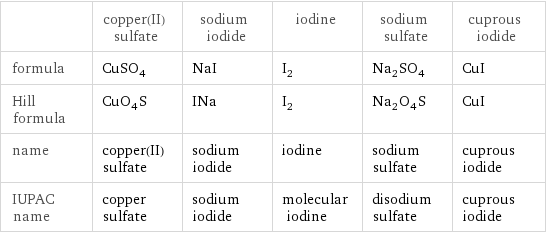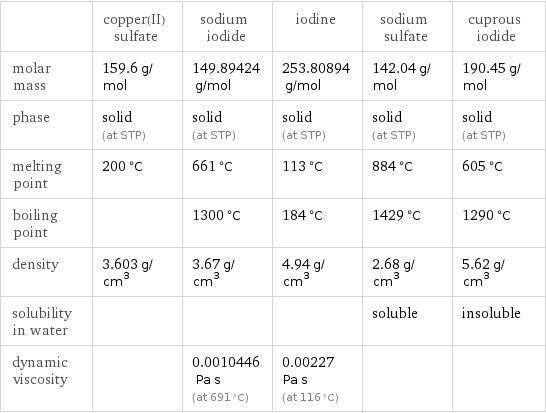Input interpretation

CuSO_4 copper(II) sulfate + NaI sodium iodide ⟶ I_2 iodine + Na_2SO_4 sodium sulfate + CuI cuprous iodide
Balanced equation

Balance the chemical equation algebraically: CuSO_4 + NaI ⟶ I_2 + Na_2SO_4 + CuI Add stoichiometric coefficients, c_i, to the reactants and products: c_1 CuSO_4 + c_2 NaI ⟶ c_3 I_2 + c_4 Na_2SO_4 + c_5 CuI Set the number of atoms in the reactants equal to the number of atoms in the products for Cu, O, S, I and Na: Cu: | c_1 = c_5 O: | 4 c_1 = 4 c_4 S: | c_1 = c_4 I: | c_2 = 2 c_3 + c_5 Na: | c_2 = 2 c_4 Since the coefficients are relative quantities and underdetermined, choose a coefficient to set arbitrarily. To keep the coefficients small, the arbitrary value is ordinarily one. For instance, set c_3 = 1 and solve the system of equations for the remaining coefficients: c_1 = 2 c_2 = 4 c_3 = 1 c_4 = 2 c_5 = 2 Substitute the coefficients into the chemical reaction to obtain the balanced equation: Answer: | | 2 CuSO_4 + 4 NaI ⟶ I_2 + 2 Na_2SO_4 + 2 CuI
Structures

+ ⟶ + +
Names

copper(II) sulfate + sodium iodide ⟶ iodine + sodium sulfate + cuprous iodide
Reaction thermodynamics
Enthalpy

| copper(II) sulfate | sodium iodide | iodine | sodium sulfate | cuprous iodide molecular enthalpy | -771.4 kJ/mol | -287.8 kJ/mol | 0 kJ/mol | -1387 kJ/mol | -67.8 kJ/mol total enthalpy | -1543 kJ/mol | -1151 kJ/mol | 0 kJ/mol | -2774 kJ/mol | -135.6 kJ/mol | H_initial = -2694 kJ/mol | | H_final = -2910 kJ/mol | | ΔH_rxn^0 | -2910 kJ/mol - -2694 kJ/mol = -215.8 kJ/mol (exothermic) | | | |
Gibbs free energy

| copper(II) sulfate | sodium iodide | iodine | sodium sulfate | cuprous iodide molecular free energy | -662.2 kJ/mol | -286.1 kJ/mol | 0 kJ/mol | -1270 kJ/mol | -69.5 kJ/mol total free energy | -1324 kJ/mol | -1144 kJ/mol | 0 kJ/mol | -2540 kJ/mol | -139 kJ/mol | G_initial = -2469 kJ/mol | | G_final = -2679 kJ/mol | | ΔG_rxn^0 | -2679 kJ/mol - -2469 kJ/mol = -210.6 kJ/mol (exergonic) | | | |
Equilibrium constant
![Construct the equilibrium constant, K, expression for: CuSO_4 + NaI ⟶ I_2 + Na_2SO_4 + CuI Plan: • Balance the chemical equation. • Determine the stoichiometric numbers. • Assemble the activity expression for each chemical species. • Use the activity expressions to build the equilibrium constant expression. Write the balanced chemical equation: 2 CuSO_4 + 4 NaI ⟶ I_2 + 2 Na_2SO_4 + 2 CuI Assign stoichiometric numbers, ν_i, using the stoichiometric coefficients, c_i, from the balanced chemical equation in the following manner: ν_i = -c_i for reactants and ν_i = c_i for products: chemical species | c_i | ν_i CuSO_4 | 2 | -2 NaI | 4 | -4 I_2 | 1 | 1 Na_2SO_4 | 2 | 2 CuI | 2 | 2 Assemble the activity expressions accounting for the state of matter and ν_i: chemical species | c_i | ν_i | activity expression CuSO_4 | 2 | -2 | ([CuSO4])^(-2) NaI | 4 | -4 | ([NaI])^(-4) I_2 | 1 | 1 | [I2] Na_2SO_4 | 2 | 2 | ([Na2SO4])^2 CuI | 2 | 2 | ([CuI])^2 The equilibrium constant symbol in the concentration basis is: K_c Mulitply the activity expressions to arrive at the K_c expression: Answer: | | K_c = ([CuSO4])^(-2) ([NaI])^(-4) [I2] ([Na2SO4])^2 ([CuI])^2 = ([I2] ([Na2SO4])^2 ([CuI])^2)/(([CuSO4])^2 ([NaI])^4)](../image_source/d67d855a94928d7ea6e7231147666e70.png)
Construct the equilibrium constant, K, expression for: CuSO_4 + NaI ⟶ I_2 + Na_2SO_4 + CuI Plan: • Balance the chemical equation. • Determine the stoichiometric numbers. • Assemble the activity expression for each chemical species. • Use the activity expressions to build the equilibrium constant expression. Write the balanced chemical equation: 2 CuSO_4 + 4 NaI ⟶ I_2 + 2 Na_2SO_4 + 2 CuI Assign stoichiometric numbers, ν_i, using the stoichiometric coefficients, c_i, from the balanced chemical equation in the following manner: ν_i = -c_i for reactants and ν_i = c_i for products: chemical species | c_i | ν_i CuSO_4 | 2 | -2 NaI | 4 | -4 I_2 | 1 | 1 Na_2SO_4 | 2 | 2 CuI | 2 | 2 Assemble the activity expressions accounting for the state of matter and ν_i: chemical species | c_i | ν_i | activity expression CuSO_4 | 2 | -2 | ([CuSO4])^(-2) NaI | 4 | -4 | ([NaI])^(-4) I_2 | 1 | 1 | [I2] Na_2SO_4 | 2 | 2 | ([Na2SO4])^2 CuI | 2 | 2 | ([CuI])^2 The equilibrium constant symbol in the concentration basis is: K_c Mulitply the activity expressions to arrive at the K_c expression: Answer: | | K_c = ([CuSO4])^(-2) ([NaI])^(-4) [I2] ([Na2SO4])^2 ([CuI])^2 = ([I2] ([Na2SO4])^2 ([CuI])^2)/(([CuSO4])^2 ([NaI])^4)
Rate of reaction
![Construct the rate of reaction expression for: CuSO_4 + NaI ⟶ I_2 + Na_2SO_4 + CuI Plan: • Balance the chemical equation. • Determine the stoichiometric numbers. • Assemble the rate term for each chemical species. • Write the rate of reaction expression. Write the balanced chemical equation: 2 CuSO_4 + 4 NaI ⟶ I_2 + 2 Na_2SO_4 + 2 CuI Assign stoichiometric numbers, ν_i, using the stoichiometric coefficients, c_i, from the balanced chemical equation in the following manner: ν_i = -c_i for reactants and ν_i = c_i for products: chemical species | c_i | ν_i CuSO_4 | 2 | -2 NaI | 4 | -4 I_2 | 1 | 1 Na_2SO_4 | 2 | 2 CuI | 2 | 2 The rate term for each chemical species, B_i, is 1/ν_i(Δ[B_i])/(Δt) where [B_i] is the amount concentration and t is time: chemical species | c_i | ν_i | rate term CuSO_4 | 2 | -2 | -1/2 (Δ[CuSO4])/(Δt) NaI | 4 | -4 | -1/4 (Δ[NaI])/(Δt) I_2 | 1 | 1 | (Δ[I2])/(Δt) Na_2SO_4 | 2 | 2 | 1/2 (Δ[Na2SO4])/(Δt) CuI | 2 | 2 | 1/2 (Δ[CuI])/(Δt) (for infinitesimal rate of change, replace Δ with d) Set the rate terms equal to each other to arrive at the rate expression: Answer: | | rate = -1/2 (Δ[CuSO4])/(Δt) = -1/4 (Δ[NaI])/(Δt) = (Δ[I2])/(Δt) = 1/2 (Δ[Na2SO4])/(Δt) = 1/2 (Δ[CuI])/(Δt) (assuming constant volume and no accumulation of intermediates or side products)](../image_source/176bdfabe1c952adf70f6a4e89ea62dd.png)
Construct the rate of reaction expression for: CuSO_4 + NaI ⟶ I_2 + Na_2SO_4 + CuI Plan: • Balance the chemical equation. • Determine the stoichiometric numbers. • Assemble the rate term for each chemical species. • Write the rate of reaction expression. Write the balanced chemical equation: 2 CuSO_4 + 4 NaI ⟶ I_2 + 2 Na_2SO_4 + 2 CuI Assign stoichiometric numbers, ν_i, using the stoichiometric coefficients, c_i, from the balanced chemical equation in the following manner: ν_i = -c_i for reactants and ν_i = c_i for products: chemical species | c_i | ν_i CuSO_4 | 2 | -2 NaI | 4 | -4 I_2 | 1 | 1 Na_2SO_4 | 2 | 2 CuI | 2 | 2 The rate term for each chemical species, B_i, is 1/ν_i(Δ[B_i])/(Δt) where [B_i] is the amount concentration and t is time: chemical species | c_i | ν_i | rate term CuSO_4 | 2 | -2 | -1/2 (Δ[CuSO4])/(Δt) NaI | 4 | -4 | -1/4 (Δ[NaI])/(Δt) I_2 | 1 | 1 | (Δ[I2])/(Δt) Na_2SO_4 | 2 | 2 | 1/2 (Δ[Na2SO4])/(Δt) CuI | 2 | 2 | 1/2 (Δ[CuI])/(Δt) (for infinitesimal rate of change, replace Δ with d) Set the rate terms equal to each other to arrive at the rate expression: Answer: | | rate = -1/2 (Δ[CuSO4])/(Δt) = -1/4 (Δ[NaI])/(Δt) = (Δ[I2])/(Δt) = 1/2 (Δ[Na2SO4])/(Δt) = 1/2 (Δ[CuI])/(Δt) (assuming constant volume and no accumulation of intermediates or side products)
Chemical names and formulas

| copper(II) sulfate | sodium iodide | iodine | sodium sulfate | cuprous iodide formula | CuSO_4 | NaI | I_2 | Na_2SO_4 | CuI Hill formula | CuO_4S | INa | I_2 | Na_2O_4S | CuI name | copper(II) sulfate | sodium iodide | iodine | sodium sulfate | cuprous iodide IUPAC name | copper sulfate | sodium iodide | molecular iodine | disodium sulfate | cuprous iodide
Substance properties

| copper(II) sulfate | sodium iodide | iodine | sodium sulfate | cuprous iodide molar mass | 159.6 g/mol | 149.89424 g/mol | 253.80894 g/mol | 142.04 g/mol | 190.45 g/mol phase | solid (at STP) | solid (at STP) | solid (at STP) | solid (at STP) | solid (at STP) melting point | 200 °C | 661 °C | 113 °C | 884 °C | 605 °C boiling point | | 1300 °C | 184 °C | 1429 °C | 1290 °C density | 3.603 g/cm^3 | 3.67 g/cm^3 | 4.94 g/cm^3 | 2.68 g/cm^3 | 5.62 g/cm^3 solubility in water | | | | soluble | insoluble dynamic viscosity | | 0.0010446 Pa s (at 691 °C) | 0.00227 Pa s (at 116 °C) | |
Units
